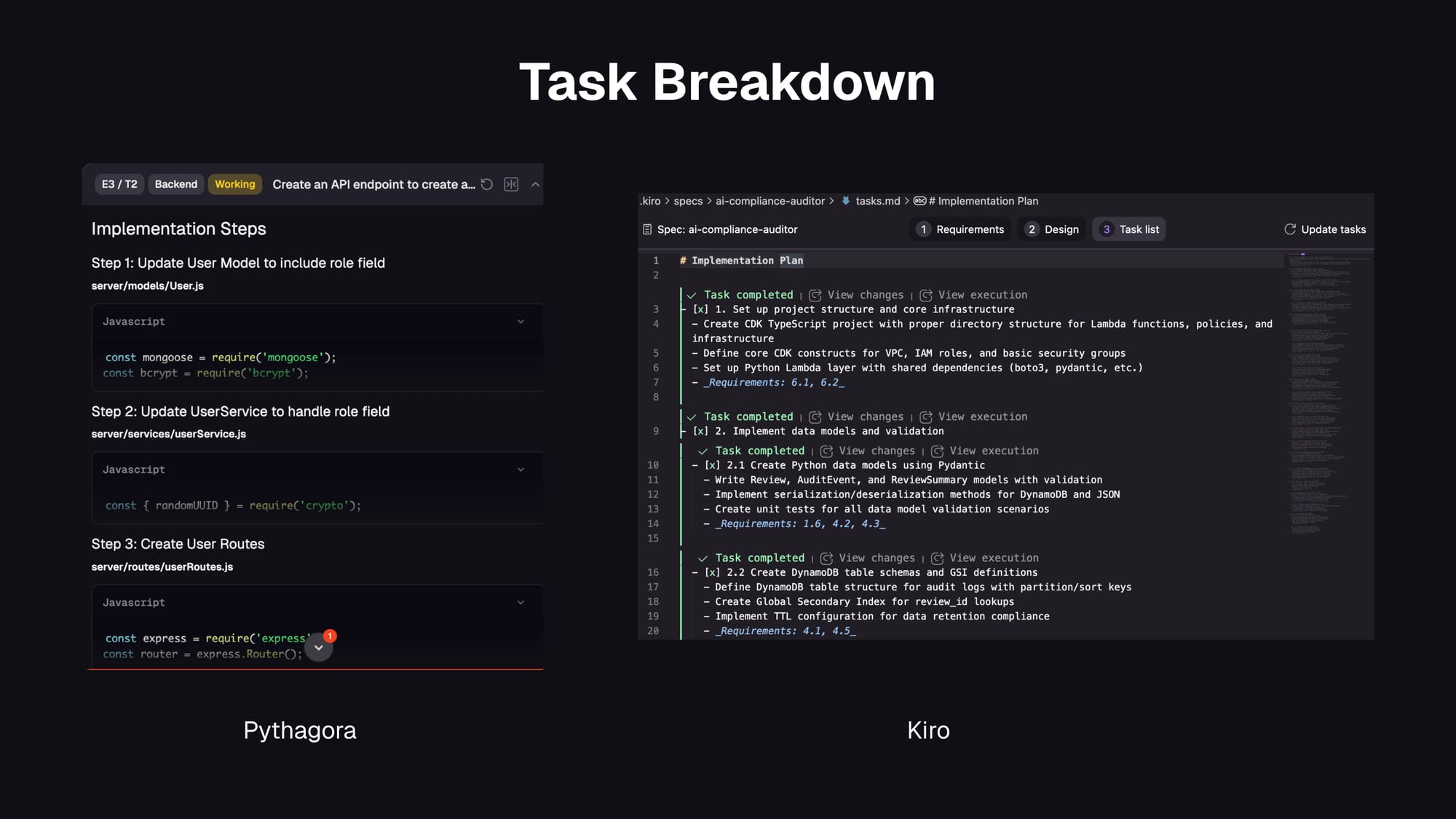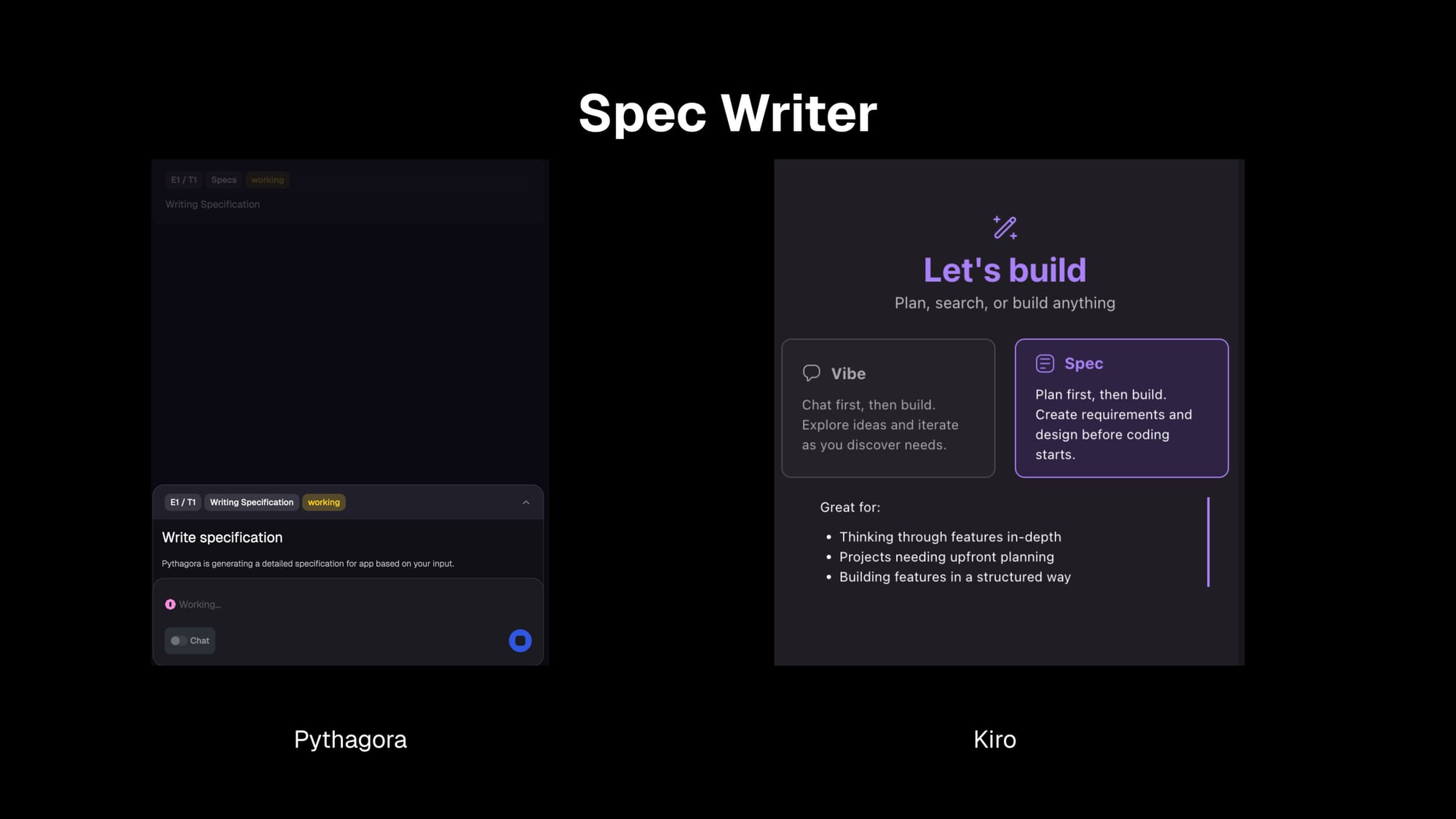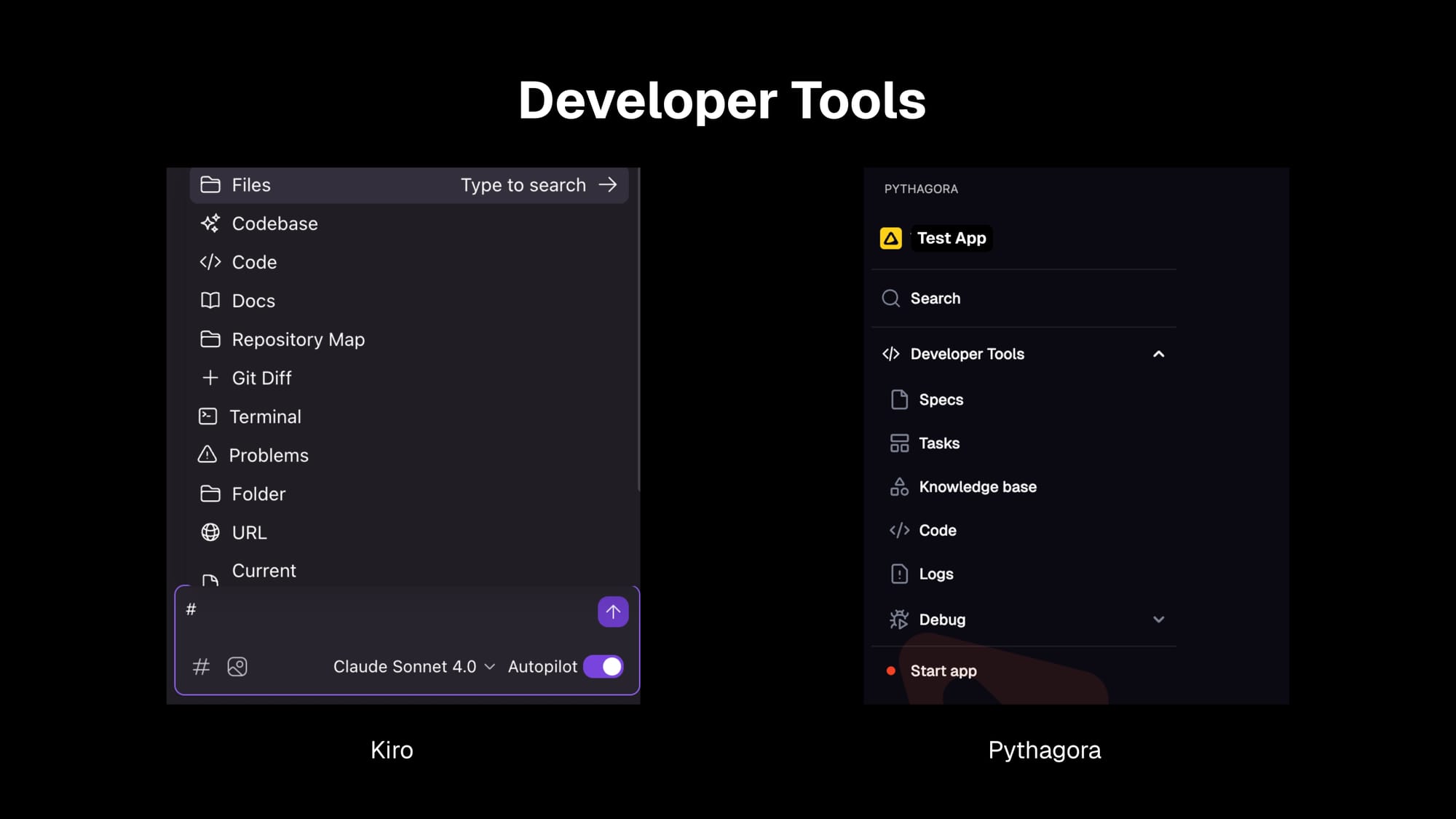The Spec-Driven Revolution: How Pythagora Pioneered What Amazon Just Validated

From Vibe to Viable: Why Amazon's Kiro Launch Proves Pythagora Was Right All Along
This week, Amazon CEO Andy Jassy announced Kiro, declaring it "has a chance to transform how developers build software" through something called "spec-driven development." As the COO of Pythagora, I couldn't help but smile. After two years of building exactly this vision and launching Pythagora 2.0 just three weeks ago after months of working on the product and UXUI, it's gratifying to see the world's largest cloud provider validate our approach.
Welcome to the spec-driven revolution. We've been waiting for you.
The Vibe Coding Crisis We Solved
Amazon's Kiro launch reveals what we've known for years: "vibe coding" in its current form is fundamentally broken. As AWS acknowledges on Kiro's FAQ page, "when implementing a task with vibe coding, it's difficult to keep track of all the decisions that were made along the way, and document them for your team."
The symptoms are everywhere:
- AI-generated projects abandoned at the first sign of trouble or trapped in endless "fix it" loops
- Code that works brilliantly in demos but crumbles under real-world complexity
- Teams rebuilding from scratch because they can't debug what AI created
- Undocumented AI-written software that becomes difficult or impossible to maintain
At Pythagora, we've been hearing these pain points from developers for two years. That's why we built our platform around a simple principle: AI should enhance the development process, not replace the fundamental discipline of software engineering.

Spec-Driven Development: Our Vision, Now Mainstream
Both Pythagora and Amazon's Kiro recognize the same fundamental truth: jumping straight from prompt to code skips the most critical step, understanding what you're actually building and how it should work.
The Pythagora Approach
When people describe an app idea to Pythagora, we don't immediately start generating code. Instead, our platform creates a comprehensive specification and task list first. Then our 14 specialized agents get to work:
- Planning agents break down requirements into manageable tasks
- Architecture agents design proper full-stack applications with layered logic
- Development agents write front-end, back-end, and database code
- Built-in debugging tools that developers can actually use: breakpoints, logs, database inspection
- Production-ready security from the very start
Results are: Complete, deployable applications with full code ownership and no vendor lock-in.
Amazon's Approach (New to Market)
Kiro works by breaking down developer prompts into structured components, requirements, design documents, and task lists, to guide implementation and testing. It automatically updates these documents as code evolves, aiming to reduce inconsistencies between what's planned and what gets built.
It's a solid approach that validates exactly what we've been pioneering. The difference? We've are all-in-one AI dev platform where you have everything in one place, secure deployment included.

Why Complete Platforms Beat Enhanced IDEs
Here's where the real distinction emerges. Kiro is described as an "AI-driven integrated development environment" that enhances the coding experience. Pythagora replaces the traditional development flow entirely.
The Platform vs. IDE Difference

When our co-founder and CEO Zvonimir Sabljic says "Where others offer building blocks, Pythagora offers an end-to-end blueprint," this is exactly what he means. You're not assembling pieces or enhancing your existing workflow, you're getting complete solutions.
What This Looks Like in Practice
Instead of describing an app idea and hoping for the best, you start with specifications, which you can always go back to if needed. Our 14 agents handle the planning, architecture, development, and debugging, but they do it systematically, not chaotically.
You get complete applications: frontend, backend, database, security. More importantly, you get debugging tools that actually work and code you can modify or deploy however you want.
The difference between this and traditional AI coding tools is significant enough that when people try Pythagora, they usually get it immediately.

The Security Reality Check
Amazon got one thing absolutely right: AI-generated software often lacks the formal structure needed for long-term support. But we went further.
At Pythagora, we made a critical architectural decision early on: security isn't outsourced to AI. If you want to offload codebase management and debugging to AI, but you don't want AI to manage your security. Period.
This isn't just philosophical, it's practical. Our platform handles security at the infrastructure level while letting AI excel at what it does best: rapid, structured development within secure guardrails. When you deploy a Pythagora-built application, you're getting enterprise-grade security without having to trust AI to understand your threat model.
Market Validation and What's Next
Amazon's entry into spec-driven development isn't just competition, it's a true validation. Just like in any other industry, especially financial services.
When the world's largest cloud provider starts building around the same principles we've been working on for two years, it just confirms everything.
The Landscape Right Now
- Amazon Kiro: Enhanced IDE experience, AWS ecosystem focus, preview pricing at $19-39/month
- Pythagora: Complete development platform, works anywhere you want to deploy it, available now starting at $49/month
The market seems ready for platforms that do more than generate code snippets. Whether that's our approach or Amazon's, the days of treating AI development tools as toys are probably and finally over.
What This Actually Means
The industry is moving from code completion tools to complete development platforms. Amazon's announcement makes that shift official, but it's been happening for a while.
We've been working on this problem since we kept seeing the same pattern: AI tools that worked great for demos but fell apart when you needed to actually ship something. Debugging AI-generated code without proper tools is miserable. Building frontend components without thinking about the backend is pointless. Getting stuck in prompt loops because you can't see what's actually happening gets old fast.
Spec-driven development fixes most of these problems, but only if you build the tooling properly. That's what we've been figuring out for two years. And trust me, it was not easy.
Where We Go From Here
The spec-driven revolution is happening whether we want it or not. Amazon's announcement just makes it official.
We've spent two years building this approach, debugging the edge cases, figuring out where AI works and where it doesn't, learning what developers actually need versus what sounds impressive in demos. The 33,000 GitHub stars and Y Combinator backing are nice, but what matters more is that we've seen teams go from idea to production with apps they can actually maintain.
Amazon's entry validates that we weren't crazy to bet everything in this direction. But validation and execution are different things. We built Pythagora because we needed it to exist, not because we thought it would be easy to build.
If you're interested in what spec-driven development actually looks like in practice, Pythagora 2.0 is available now. If you're curious about where this space is heading, we're probably the team that's thought about it the longest.
The industry is finally catching up to something we've been working on for years.
That's either vindication or just good timing, but most probably both.
Ivis
